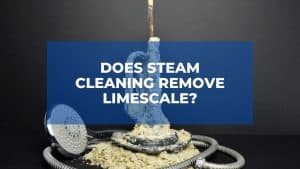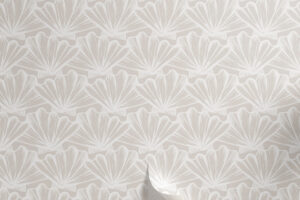Limescale, or hard water residue, is a hard, chalky, and white substance that builds up around water areas like the inner surfaces of old pipes; inside kettles & bowls; on bathroom floors and walls; and around taps to mention a few.
It reduces the life and efficiency of your home appliances, raises your electrical bills significantly, and can cause blockage in your pipes when left to build up for longer periods. The residue also looks ugly around your bathroom and kitchen.
While there’s a dire need to get rid of limescale from homes periodically, most homeowners aren’t well-informed of the most effective way to do so. But one of the most talked-about methods is steam cleaning.

Many people ask, “Does steam cleaning remove limescale,” and you might be asking the same. Luckily, we have the right answers. We also explain more that you need to know concerning steam cleaning and limescale removal.
Quick Navigation
Does Steam Cleaning Remove Limescale?
Yes. Steam cleaning uses high temperature and pressure to break down limescale naturally without chemicals. It also kills 99.9% of bacteria and germs.
What Causes Limescale?
Limescale is mainly caused by hard water, which usually contains minerals like calcium and magnesium. When temperatures rise, water evaporates and leaves behind the minerals, which clump together to create limescale.
These minerals usually have a higher boiling point and will not evaporate along with water. Limescale can also collect over time without evaporation. The deposits left behind are mainly made of calcium carbonate or magnesium carbonate.
So, if you’re living in hard-water areas, you’re likely to experience the effects of hard water stains. Luckily, below is a guide on how to get rid of it using a steam cleaner.
How to Remove Limescale Using A Steam Cleaner
Use the following guidelines to eliminate limescale from your sinks, bathroom floors, kettles, taps, and other surfaces forever. But please remember to use your steam cleaner only on recommended surfaces as it may destroy others.
1. Get The Steam Cleaner Ready
Start by filling your steam cleaner’s reservoir with distilled water. Do not use hard water because it destroys the machine and voids its warranty.
Then, plug the steam cleaner in so that it heats to the ideal temperature. Recommended temperatures are between 220°F and 320°F. If your steam cleaner can’t reach such temperatures, consider hiring one.
2. Choose The Right Attachment
The right attachment will help you clean faster and more easily. They reach hidden areas as well as clean the surface more thoroughly. We recommend using the brush and nozzle attachments. So find one before the process starts.
3. Steam Clean Slowly And Carefully
Start cleaning slowly and carefully using the nozzle attachment. Remember to point directly to the hard water stains for the best results.
Then, use the brush attachment to scrub off more stubborn stains from the surface. The brush will also help remove sticky substances.
4. Rinse with Clean, Fresh Water
Steam cleaning usually only loosens but does not remove the dirt away from the surfaces cleaner. Therefore, you need to rinse off everything after steam cleaning. Use only fresh water to avoid future limescale problems.
Can You Use Vinegar In A Steam Cleaner?
Vinegar is a strong, acidic cleaning solution that has been known to be effective for a long period. Being an acid, it reacts with limescale to produce soluble salts that can simply be washed away.
Vinegar does not harm your steam cleaner when used in diluted form. Otherwise, full-strength vinegar will shorten the life of your steam cleaner.
Add one or two cups of vinegar to a gallon of water, and that’s enough. Always use vinegar on surfaces it cannot destroy. For instance, the acid may be dangerous to your hardwood flooring.
Please remember to run the cleaner with clean water after using vinegar to ensure that its remains are eliminated.
How Do You Remove Limescale From A Steam Cleaner?
Steam cleaners may also accumulate hard water stains, especially in their boilers. Generally, all types of water contain minerals.
So it’s not a surprise that steam cleaners can accumulate limescale, too, over time. And this usually has effects on its performance and life. The question most people ask is, “how can I descale my steam cleaner?” Well, here is the process.
- Find an appropriate descaler for the job. You can make one by mixing 1.5 oz of baking soda and one quart of water.
- Fill your steam cleaner’s empty water reservoir with this mixture, plug it in, and turn it on to start heating.
- When it has heated and cooled for around one hour, use the steam cleaner to spray steam for about two minutes and allow it to cool again for 2 hours.
- When it’s fully cooled, unplug the machine and empty the reservoir/tank.
- Flush clean water through the system again and all is well.
Note: Do not use anything else apart from water in your steam cleaner except when descaling it.
Can You Steam Clean A Glass Shower Door?
Shower doors are known to accumulate a lot of limescale and soap scum. The unsightly film is usually hard to get rid of through normal scrubbing. But with a steam cleaner, you can get the job done within minutes.
So, yes, you can clean glass shower doors with a steam cleaner. It will remove limescale and soap scum besides killing bacteria and eliminating scale. Simply prepare the steam cleaner, blast the door from top to bottom, and pat-dry it after cleaning.
How Long Should I Steam Clean Limescale?
The period over which you should hold a steam cleaner over limescale so that you break it completely depends on how hard the scale is. We recommend holding it for 3-4 seconds for softer limescale and up to 10 seconds for hard limescale.
Can I Use Hydrogen Peroxide in My Steam Cleaner?
Hydrogen peroxide is an acid. Acids react with limescale to produce soluble metal salts that you can simply wipe away.
But is it worthy and or safe to use it inside your steam cleaner? The answer is yes, but you only need to add it in its diluted form. We recommend a 3% solution to avoid damaging your machine and surfaces alike.
Can Limescale Become Permanent?
Limescale usually hardens over time, which is why we recommend that you remove it regularly. If left for very long periods, limescale can become extremely hard or even permanent on surfaces.
How Can I Remove Limescale From Pipework?
Limescale in your pipework can reduce the pressure of your water or cause blockage. Before it causes such damage, you need to clear it out in some way. Although it can be difficult, it’s still achievable. Here are a few important steps to follow:
- Add a cup of baking soda down the drain. You can use a funnel or any homemade tool that can get the work done perfectly.
- Add several liters of white vinegar to the same pipe (the amount depends on the length of your pipes), ensuring that it penetrates properly.
- Do this for all baths and or basin drains in your home, leaving each of them to rest for around 3 hours.
- Boil fresh water and add it to each of the drains to help wash away the leftover limescale, soap residue, and other remains.
How Does Boiling Water Affect Its Hardness?
Boiling water precipitates the minerals that cause temporary hardness in water (solid calcium or magnesium hydrogen carbonate). During boiling, the mixture separates into water, calcium (or magnesium) carbonate, and carbon dioxide.
However, permanent hardness is non-carbonate and is caused by dissolved calcium (or magnesium) sulfates. It cannot be removed by simply boiling the water.
Remember To:
- Always wipe dry water taps, work surfaces, screens, and other areas to prevent water from sitting there and accumulating limescale.
- Remove limescale regularly from your surfaces to prevent more buildup and harness that could hike the cost of removal.
- Only use your steam cleaner with fresh water.
- Use diluted acids to remove limescale from delicate areas like wooden floors, thin glasses, and other surfaces.
- Descale your steam cleaner regularly to help extend its life and maintain its efficiency.
- Contact specialists if the problem persists.
The Bottom Line
While limescale may not be harmful to your health, it causes trouble in your pipes, reduces water pressure, destroys your home appliances, and raises your energy bills to mention a few. Removing it regularly will help prevent buildup and some of these problems.
It’s good news that steam cleaning is very effective at not only removing limescale but also killing bacteria and eliminating stains from your home. Use the guidelines highlighted above for the best results.
Meanwhile, we hope that this article helps you get the most out of your steam cleaner while educating you on other things around limescale and its removal. Good luck!


